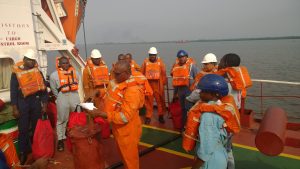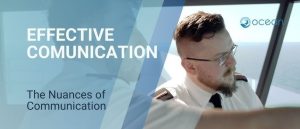Effective leadership and communication skills are crucial for managing shipboard teams and ensuring smooth maritime operations. Onboard ships, where crew members come from diverse cultural backgrounds and work in challenging environments, strong leadership and clear communication are essential for operational success, safety, and team cohesion. This article explores key leadership traits, communication strategies, and techniques that drive team success in the maritime industry.
Leadership onboard ships extends beyond rank and authority. It involves guiding, motivating, and managing a team while fostering a positive work environment. Successful shipboard leadership ensures:
- Operational Efficiency: Clear instructions reduce operational errors and enhance productivity.
- Safety Compliance: Adherence to safety protocols through effective leadership minimizes accidents.
- Crew Morale: Supportive leadership boosts crew morale and job satisfaction.
- Crisis Management: Strong leaders handle emergencies effectively, ensuring timely responses.
Key Leadership Traits for Seafarers
Successful maritime leaders share specific traits that enable them to manage diverse shipboard teams efficiently:
1. Decision-Making Ability: Make timely and well-informed decisions, especially in high-pressure environments. Example: A ship’s captain deciding on route adjustments during severe weather.
2. Accountability: Take responsibility for team performance and operational outcomes. Example: Chief engineers maintain ship engine performance and ensure timely maintenance.
3. Integrity and Trustworthiness: Build trust through ethical conduct and transparency. Example: First officers conducting fair performance evaluations and promoting crew welfare.
4. Adaptability: Adjust strategies based on changing maritime conditions. Example: Navigating shipping delays caused by port congestion.
5. Conflict Resolution Skills: Address disputes proactively and ensure team harmony. Example: Resolving interpersonal conflicts among crew members.
Communication Techniques for Shipboard Teams
Clear communication onboard ships prevents misunderstandings, reduces operational risks, and enhances teamwork. Effective communication involves both verbal and non-verbal methods, ensuring clarity and understanding in diverse and high-stakes maritime environments.
Standardized Communication Protocols
Following the IMO’s Standard Marine Communication Phrases (SMCP) is crucial for maintaining clarity and consistency. For example, SMCP is commonly used for radio communication during navigation maneuvers, ensuring precise and unambiguous exchanges.
Active Listening
Encouraging crew members to voice concerns and provide feedback is vital for fostering collaboration. Engineering officers, for instance, enhance decision-making by listening to maintenance crew reports during inspections, creating an environment of mutual respect and understanding.
Clear and Concise Instructions
Providing specific and direct instructions is essential for executing critical tasks effectively. A captain issuing precise docking procedures to the bridge team minimizes confusion and ensures efficient task performance.
Multilingual Communication Support
On international vessels, supporting multilingual communication is often necessary. Translators or a common working language like English can bridge language barriers. For instance, conducting safety drills in English and translating key points as needed ensures all crew members understand the procedures.
Visual Communication Tools
Diagrams, signage, and digital dashboards are effective non-verbal methods of conveying information. For example, a centralized monitoring screen displaying engine status helps crew members quickly grasp operational updates and act accordingly.
By combining these techniques, maritime teams can ensure effective communication, strengthening operational efficiency, safety, and team cohesion.

Developing Leadership and Communication Skills in Seafarers
Training and development programs play a key role in enhancing leadership and communication skills. Recommended strategies include:
1. Leadership Development Programs
- Provide maritime-specific leadership courses accredited by recognized institutions.
- Example: The IMO’s Model Course 6.09 on training instructors includes leadership components.
2. Simulation-Based Training
- Use bridge and engine room simulators to practice communication during emergency scenarios.
- Example: Conducting simulated search-and-rescue missions in bridge simulators.
3. Crew Resource Management (CRM) Training
- Introduce CRM programs focusing on teamwork, decision-making, and interpersonal communication.
- Example: CRM workshops for bridge teams navigating through congested waters.
4. Performance Feedback Systems
- Implement regular performance reviews with constructive feedback.
- Example: Conducting quarterly assessments on leadership effectiveness during drills.
5. Cultural Awareness Workshops
- Promote understanding of cultural differences and workplace diversity.
- Example: Conducting cultural sensitivity training sessions for multicultural crews.
Case Studies: Leadership and Communication Success Stories
Case Study 1: Successful Crisis Management During a Fire
A cargo ship experienced an engine room fire that threatened onboard safety. The chief engineer led the firefighting response by issuing precise instructions, maintaining open radio communication with the bridge, and ensuring proper crew deployment. His decisive leadership minimized damage and ensured crew safety.
Case Study 2: Navigational Success through Team Collaboration
A tanker successfully avoided a potential collision during restricted visibility thanks to effective bridge team communication. The captain conducted a thorough pre-sailing briefing, emphasizing specific navigational roles and communication protocols. During the voyage, prompt communication between the lookout, helmsman, and officer on watch enabled swift corrective actions.
Future Trends in Maritime Leadership and Communication
Advancements in maritime technology continue to influence leadership and communication strategies:
- Remote Monitoring: Shore-based teams supporting onboard operations require precise communication protocols.
- AI-Assisted Decision Making: AI-powered systems provide data-driven insights, supporting leaders in decision-making.
- Digital Training Platforms: E-learning modules and virtual reality (VR) simulations enhance leadership and communication training.
Leadership and communication skills are vital for seafarers to manage shipboard teams, ensure operational efficiency, and respond effectively to emergencies. By cultivating strong leadership traits, mastering communication techniques, and investing in continuous crew development, the maritime industry can build cohesive, efficient teams ready to meet the challenges of modern seafaring. As technology and industry standards evolve, fostering leadership excellence will remain central to successful maritime operations.





Thanks for the article.
Thanks for the article
Thanks for the article
Hello there!